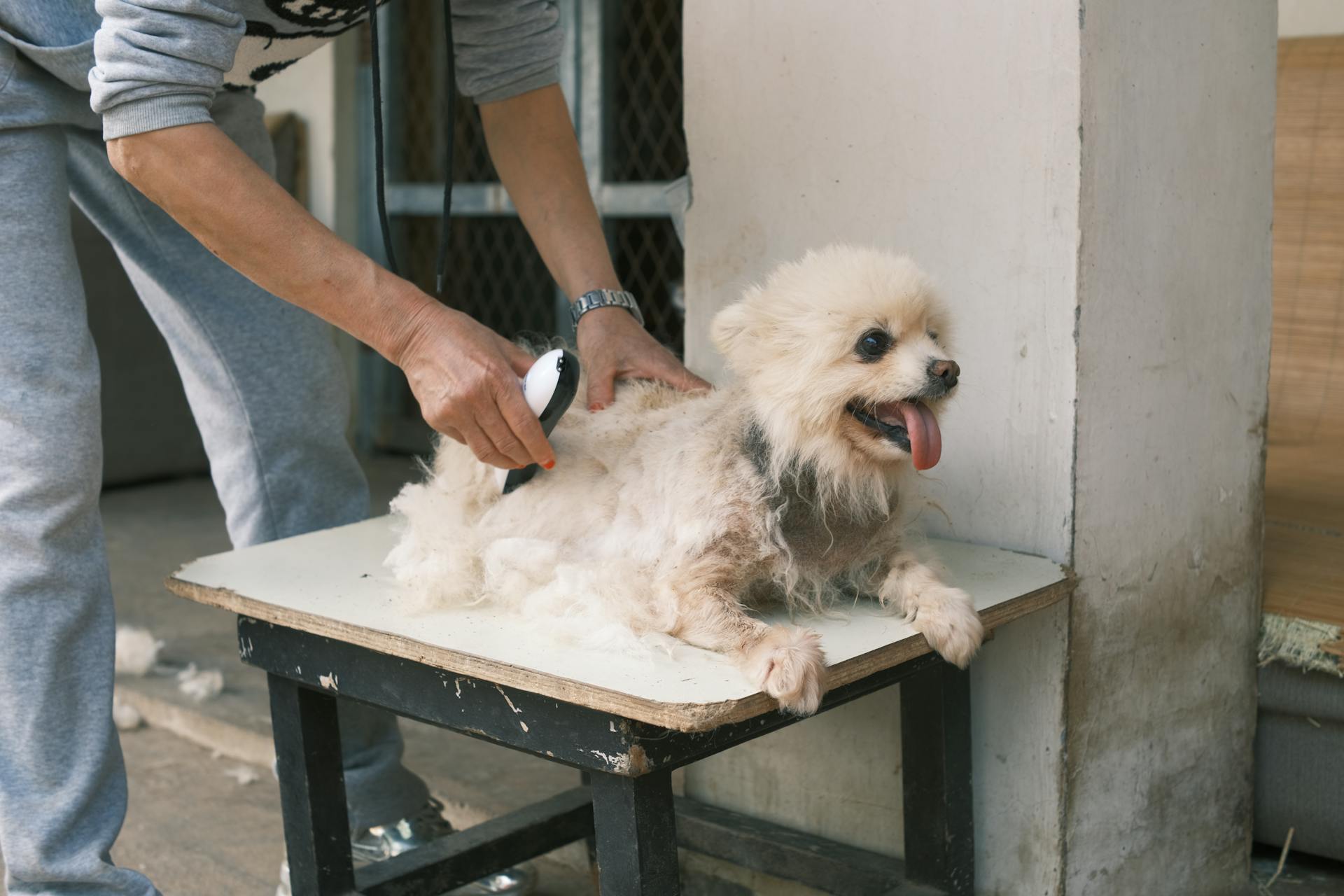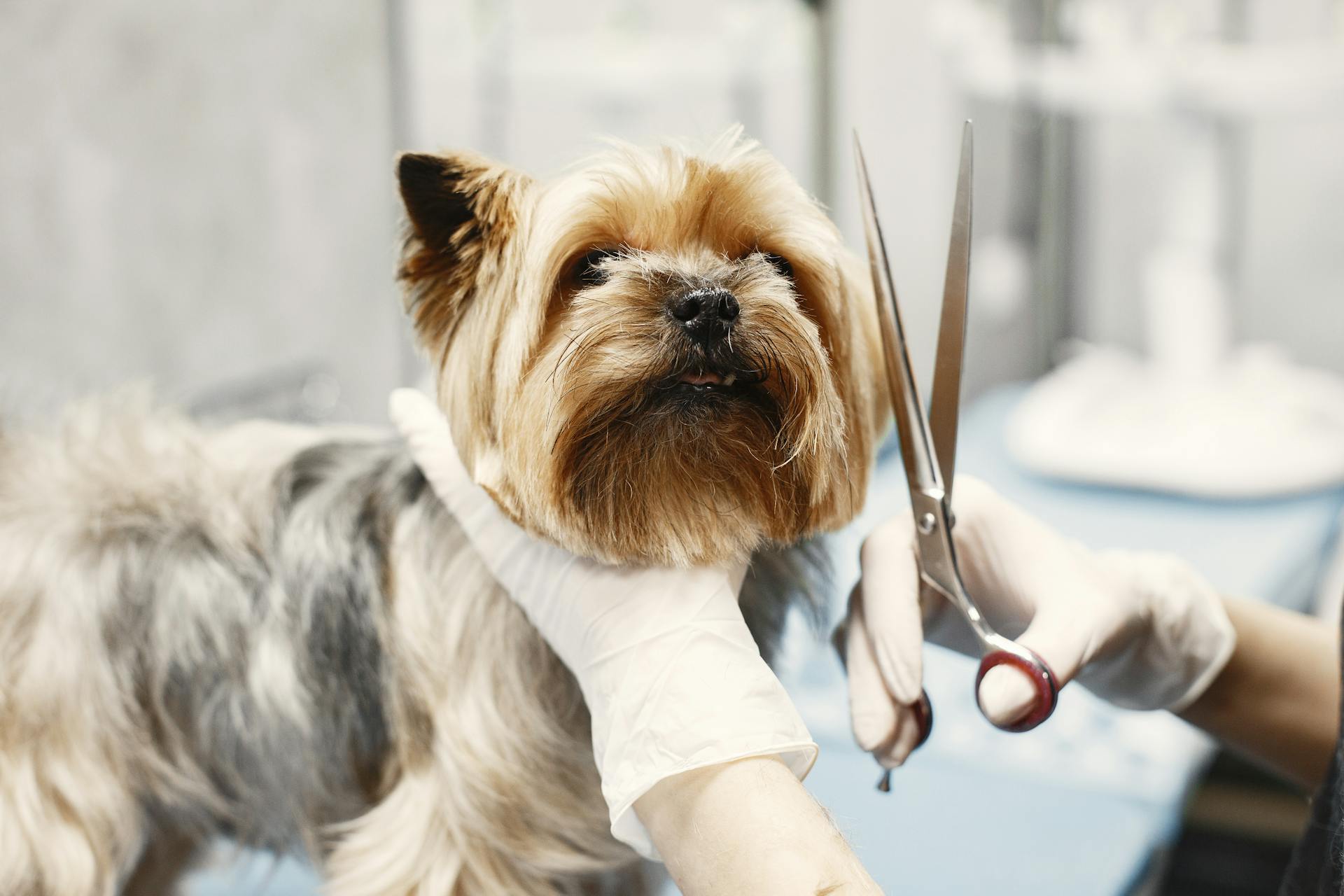
Grooming can be a stressful experience for dogs, especially those with anxiety or fear issues.
A sedative can help calm them down, making the process much smoother.
There are several types of dog sedatives available, each with its own unique characteristics.
Some sedatives, like acepromazine, are often used for grooming due to their rapid onset of action.
However, it's essential to use sedatives responsibly and with caution.
Always consult with a veterinarian before administering any sedatives to your dog.
Some sedatives, like phenobarbital, can have serious side effects if not used correctly.
This is why it's crucial to follow the veterinarian's instructions carefully.
Choosing a Sedative
If you're considering a sedative for your dog's grooming, you have a few options. Over-the-counter calming supplements can be administered 30 minutes to 90 minutes before the appointment.
Benadryl is also a common choice, but it may not be enough to fully alleviate anxiety in some dogs. Its effects are not powerful enough to make the anxiety fully go away in many cases.
General anesthesia may be necessary for critical cases, such as dogs with painful mats or those that require extended periods of stillness. This is usually done at the vet's office.
If you do decide to use a sedative, it's essential to weigh the potential benefits against the risks of side effects. Some sedatives can cause lethargy, which may not be ideal for all dogs.
Types of Sedatives
There are several types of sedatives that can be used for dog grooming. Benadryl, an over-the-counter antihistamine, is often used to calm anxious dogs, but its effects are not powerful enough to completely eliminate anxiety in all dogs.
For more critical cases, general anesthesia may be necessary, especially if the dog is in pain or needs to remain still for an extended period.
Oral sedatives, such as Acepromazine, can be administered to help calm the dog, and are often used in combination with other drugs like diazepam or butorphanol. Injectable sedatives, on the other hand, tend to have a faster and more effective response, and are often preferred by veterinarians.
Additional reading: How Often Dog Grooming
Some sedatives can be "reversible", meaning the pet can be awakened quickly after the procedure is complete. Others may simply wear off, allowing the pet to regain consciousness once the effects of the drug have faded.
The most commonly used types of sedatives include:
It's essential to consult with a veterinarian to determine the most suitable sedative for a specific dog, as each pet's needs and circumstances are unique.
Candidates
Pets that struggle with aggression are candidates for sedated grooming.
Visits to the veterinarian or groomers can be a great way to socialize pets and help them become more comfortable with handling by others.
Pets that easily stress out may also benefit from sedated grooming to make the experience less overwhelming.
Heavy matting can cause physical pain for pets, making them good candidates for sedated grooming.
Preparing for Grooming
Get your dog accustomed to visiting the veterinarian and groomers to make the experience less stressful for both of you. Exposing your pet to new places, especially at a young age, will help them become more confident and calm in new situations.
Take your time and pace new experiences according to your pet's response, especially if they're adopted at a later age. This will help them adjust to new environments and people.
To prepare your dog for grooming, make sure to follow the same steps as preparing them for sedation or anesthesia. This includes fasting for at least 12 hours before the grooming session, to prevent any complications during the procedure.
Start Early
Exposing your pet to various situations and experiences at a young age is crucial for its overall well-being. This includes introducing them to baths and brushing, which can help them become more comfortable with grooming as they grow.
Gently rubbing your pet's head, body, feet, and ears on a daily basis can help them become more relaxed and accepting of grooming.
Broaden your view: Dog Hair Everywhere Pet Grooming
Wedding Planning for Groom
Planning for a groom's grooming session requires a medical consultation, especially if sedation is needed due to anxiety issues. The veterinarian will evaluate the pet's health status and create a sedation protocol.

A sedation consultation is scheduled as a regular exam appointment and costs the same as a regular exam. This consultation is vital to ensure the pet's safety under anesthesia.
Blood work may be required in some cases, and a written estimate for the cost of the sedation procedure and grooming will be provided after the consultation.
Preparing Myself
Fasting is a crucial step in preparing for grooming, just like it is for surgery. Aim to fast your dog for at least 12 hours before the procedure.
Monitoring your dog's behavior is essential to ensure they're healthy enough for grooming. Keep an eye out for any new signs of illness or unusual behavior, and let your groomer know if you notice anything unusual.
Your dog may feel anxious or nervous during grooming, so it's essential to soothe them with reassurance and affection. Give them lots of hugs, pats, and kisses to make them feel more at ease.
After grooming, your dog will need some time to rest and recover. Prepare a quiet, warm, and comfortable space for them to relax in when they return home.
Here are some additional tips to help you prepare for your dog's grooming:
- Make sure your dog is comfortable and secure in their carrier or harness during transport to the groomer.
- Provide your groomer with any relevant medical information or allergies your dog may have.
- Discuss any concerns or anxieties your dog may have with your groomer beforehand.
Grooming Process
Sedation for dogs is often necessary for grooming procedures like ear cleaning and nail clipping, especially for dogs with anxiety or reactivity issues.
Vets may administer sedatives to help your dog relax and stay calm during these procedures.
Dogs that receive sedation for grooming usually have some time to recover at the vet before they're ready to go home.
What Procedures Require Sedation
Some procedures require sedation for dogs to remain calm and still, such as ear cleans, grooming, fur clipping, and nail clips.
Dogs with anxiety or reactivity issues may need sedation for these routine procedures.
Sedatives can help your dog relax or sleep, making it easier for the vet to treat your pet.
Vets often administer sedatives during diagnostic tests like X-rays, MRIs, and CAT scans to get accurate results.
After the procedure, your dog will usually be given time to recover at the vet before being ready to go home again.
What to Expect
As you bring your furry friend to the groomer, you're probably wondering what to expect during the process. Your dog will likely be given sedatives to help them relax and stay still, which is especially helpful for procedures like ear cleaning, grooming, and nail clipping.
Sedatives can cause your dog to calm down, relax, or sleep, making it easier for the groomer to work on them. This is especially important for dogs with anxiety or reactivity issues, as it helps them feel more at ease.
The type and amount of sedative used will depend on your dog's specific condition, medical history, and physical exam results. Your vet will determine the best course of action to ensure your dog's safety and comfort.
After the procedure, your dog will likely be a bit groggy and lethargic, which is normal and should wear off within a few hours or days. They may also have some light bruising from the IV or catheter insertion site.
For another approach, see: Dog Grooming Usa & Groomer Artist Academy
Here are some common behaviors to expect during the sedation recovery period:
- Grogginess: Your dog may be drowsy or groggy after the sedative has worn off.
- Lethargy: Your pet may be lethargic and unwilling or unable to move much.
- Bruising: Bruises may appear on the area where the IV or catheter is inserted.
If you notice anything that worries you, such as difficulty waking up or signs of infection, be sure to contact the vet immediately.
Frequently Asked Questions
Will Benadryl calm my dog for grooming?
Benadryl may help calm your dog for grooming, but it's just one option and not a guaranteed solution. Consider exploring other alternatives to find the best approach for your dog's anxiety.
How much does it cost to put a dog to sleep for grooming?
Sedation costs for dog grooming range from $50 to $200, depending on the dog's size and the type of procedure. The cost may vary based on whether the procedure is routine or an emergency.
Sources
- https://www.legacyamc.com/site/blog/2023/02/28/how-calm-dog-grooming
- https://www.lonetreevet.com/blog/the-ins-and-outs-of-a-sedated-grooming/
- https://xenpets.com/blogs/daphnes-dog-blog/sedation-dog-grooming-proving-relief-during-stressful-times
- https://pawfectspa.com/do-dog-groomers-give-dog-sedatives/
- https://pawsandmorevet.com.au/dog-sedation-and-anaesthesia/
Featured Images: pexels.com


